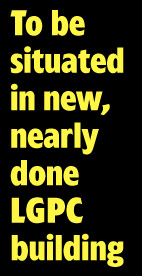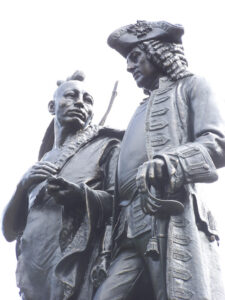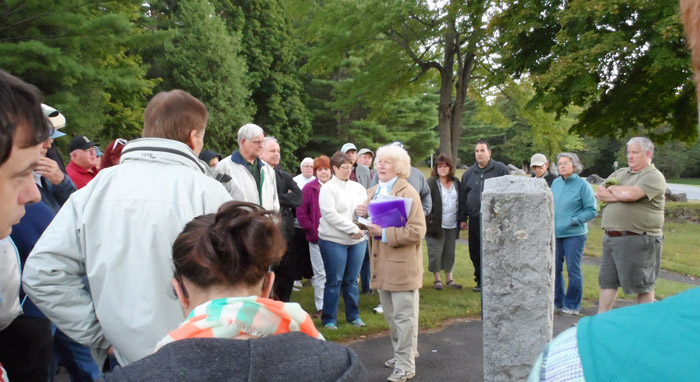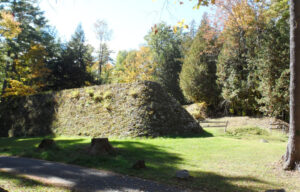By Cathy DeDe, Chronicle Managing Editor

A hundred years as a concept, 20 years in the pursuit, and now with two years of effort and a bit of fortunate happenstance, the Lake George Battlefield Park will finally this summer get a Visitor Interpretive Center and museum. It’s expected to open in early summer, on the ground floor of the new Lake George Park Commission headquarters building on Fort George Road.
“They talked about a museum on the site when the park was first created in 1898, says Lynda “Lyn” Hohmann. She heads the Lake George Battlefield Park Alliance, which revived the museum idea when it was founded by a group of enthusiasts 20 years ago.
Of their several goals, Dr. Hohmann said, “the nearest and dearest was always a visitor interpretive center where people could see the historical information about the park.” What they lacked was money, not inspiration.
Battlefield Park is rich in history, and the park is dotted with unique monuments — including the Isaac Jogues statue depicting the martyred and, in 1930, sainted French missionary who gave Lake George its original name Lac du Saint Sacrement; the statue of Sir William Johnson (who renamed Lake George for King George II) with his Mohawk ally King Hendrick; and the so-called “Kneeling Indian” depicting a Mohawk warrior.
It also contains remnants of several fortifications, burial grounds and encampments — and yet, these go largely unrecognized or unexplained, Dr. Hohmann says.

“The average person who comes to Battlefield Park will maybe see a few things, but not know what they are. There’s a lot of things there, but people walk right by.”
A very brief history catch-up:
Located on the lake’s south shore and operated by the New York State Department of Environmental Conservation, the mostly green expanse includes the sites of the 1755 Battle of Lake George and the siege of Fort William Henry in 1757.
It was the site of a major military camp from 1754 to 1763 during the French and Indian War, housed a military hospital and supply base during the early years of the American Revolution, and still contains ruins of an unfinished fort, now called Fort George, that was built in 1759.
“Native Americans, explorers and any other people figure into the history of the site,” writes DEC. “Many monuments and interpretive panels can be found throughout the Park, which commemorate and explain the role the site plays in American (and Canadian) history.”
“The location is pretty important in the history of New York State and North America,” DEC Historic Preservation Officer Charles Vandrei tells The Chronicle.
He said, “It was part of the travel corridor” including the Hudson River, Lake George, Lake Champlain and the Richelieu River, that “the French and English used…to get at each other. It was a logical place to encamp and stage cannons, probably as early as the 1740s,” among other historical moments and battles Mr. Vandrei relates.
“All of this stuff happened right here in the early history of the United States.”
Mr. Vandrei says, “When the park was created in 1898, it was about the time Gettysburg was created, with all the monuments everywhere. That’s what they had in mind, they intended a Victorian style memorial park, where people walked around and thought about things.”
“There is a lot of symbolic value here that is not really known, because the site wasn’t ever interpreted,” Mr. Vandrei says.

That’s where the museum comes in, along with the Lake George Park Commission and DEC.
Located on Fort George Road, across from DEC’s Battlefield Park, the Park Commission for years has had its offices in a DEC building that is converted old house purchased in 1909.
Finally, says Park Commission Executive Director David Wick, the state decided the building needed replacing.

The three organizations — DEC, LGPC and the Battlefield Alliance — came together a couple of years ago to plan the new pre-fab building to include headquarters for the Park Commission on two floors upstairs, and the long-wished-for Battlefield Park museum downstairs in the basement.
“I’m excited,” says DEC Historic Preservation Officer Mr. Vandrei. “This is probably one of my favorite sites to work with in the state.”
He notes that the Battlefield Park is part of a roughly 100-acre DEC property including Million Dollar Beach and the Battlefield Park campground.
“We had always thought about using the Park Commission building as a museum, but it just never happened,” says Mr. Vandrei. “Finally, the stars aligned. The Park Commission needed more space and we had opportunity to do it.”
LGPC executive director Mr. Wick says, “We think it’s awesome. I’m a big fan of mixed use and getting efficiencies where we can.”
New $1-million building will house both the LGPC & Battlefield Museum
The new Lake George Park Commission building nearing completion on Fort George Road is a pre-fab paid for by the state that will cost “about $1 million overall” including computer and phone systems, a new, environmentally sound porous paved parking lot and sidewalks, said LGPC Executive Director Dave Wick.
It’s about 6,000 square feet, on three levels — two for the Park Commission, including new, large meeting rooms they hope to use for public programming they didn’t have room for in the old building, and the 2,000 square-foot ground floor —opening onto the park — for the long sought Lake George Battlefield Park Museum.
The Battlefield Alliance “is the energy behind the museum,” said DEC Historic Preservation Officer Charles Vandrei.
The group will be responsible for all the exhibits and displays, funded through grants, foundations and donations.
“That is our space to run,” said Dr. Lyn Hohmann, who heads the all-volunteer Alliance. They will staff and operate the museum, day to day, she said.
She said they plan to collaborate with the Fort William Henry — which has held large-scale historical battle reenactments in the park — and the Lake George Historical Association.
Dr. Hohmann says, “The museum will have a historical timeline, starting with the Native Americans, the French & Indian War, Revolution and beyond — what was there, and who was there.”
Rick Conley of Hudson Falls will display his wooden scale models of Fort George and a stockade fort that was on the site. He created the models from extensive historical research including a rare photograph from 1759, Dr. Hohmann said.
The New York State Museum in Albany will share items uncovered on site in archaeological digs by the late David Starbuck. “All the artifacts from the park have just been held in storage at the State Museum, until now,” Dr. Hohmann says.
There are buttons, for example, one from a soldier in 1776. “We don’t have his name, but we have his button,” she says.
There’s also a planned display on John Bush, a Black soldier from Massachusetts famous for his carved powder horns.
Dr. Hohmann describes herself as an amateur history enthusiast who worked alongside Dr. Starbuck on several digs.
Her great find: “Last Memorial Day, I discovered an outline on the surface of the ground and realized it was a bastion of the fort.” It is discernible, she said, if you know where to look — or, we might add, if you have a museum that shows where.
Copyright © 2021 Lone Oak Publishing Co., Inc. All Rights Reserved
 Glens Falls Chronicle Serving the Glens Falls/Lake George region; Warren, Washington and northern Saratoga counties since 1980
Glens Falls Chronicle Serving the Glens Falls/Lake George region; Warren, Washington and northern Saratoga counties since 1980

